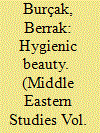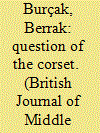| Srl | Item |
| 1 |
ID:
158076


|
|
|
|
|
| Summary/Abstract |
This article examines discussions on Ottoman-Muslim female beauty, health and hygiene in the Hamidian Era (1876–1909). Analysing the Hamidian popular press, advice literature and textbooks for girls, the article argues that these discussions were more than just female ‘physical culture’ debates, involving larger issues of late-Ottoman regeneration. Wars, epidemics, massive migration movements and fluctuations in population pushed the late-Ottoman state to create healthy generations as a productive force to secure the Empire's future in general and the Ottoman Muslim population's welfare in particular. Maintaining good health expanded from a religious obligation into now also becoming a patriotic duty incumbent upon Ottoman subjects knowing and applying modern hygienic principles. Focus on Ottoman-Muslim women's procreativity shifted female beauty into a public discussion, now defined as a reflection of health. The new hygienic beauty discourse distinguished between preserving vs. harming one's health in the face of Western fashions and cosmetics: healthy beauty mirrored a ‘good complexion’.
|
|
|
|
|
|
|
|
|
|
|
|
|
|
|
|
| 2 |
ID:
190322


|
|
|
|
|
| Summary/Abstract |
This article examines discussions on the corset in the illustrated press, text-book for girls, and medical and advice literature in the reign of Sultan Abdülhamid II (1876–1909). The article argues that the corset functioned as a cultural benchmark establishing the terms of Ottoman Muslim female sartorial decorum in a larger medicalized public debate on modern indoor dress. Hamidian reformers responded to a set of intertwined but rather conflicting requirements placed upon Ottoman Muslim women’s bodies, then positioned as the central pillars in Muslim community building. Caught between consumer desires for fashion, and the health, of the Muslim population, and stalled by a traditional discourse to regulate female indoor dress, Hamidian reformers mobilized a medicalized discourse associating dress, health and patriotism. Debates over the corset insisted on authentic Ottoman Muslim femininity by drawing upon the binaries of fashion against health, foreign against Muslim, and beautification against beauty. Corset debates opened the path towards shifting female beauty and its preservation from an individually pursued private aesthetic into a scienticized public debate which represented moral virtue and patriotic duty towards the larger goal of communal and imperial wellbeing.
|
|
|
|
|
|
|
|
|
|
|
|
|
|
|
|